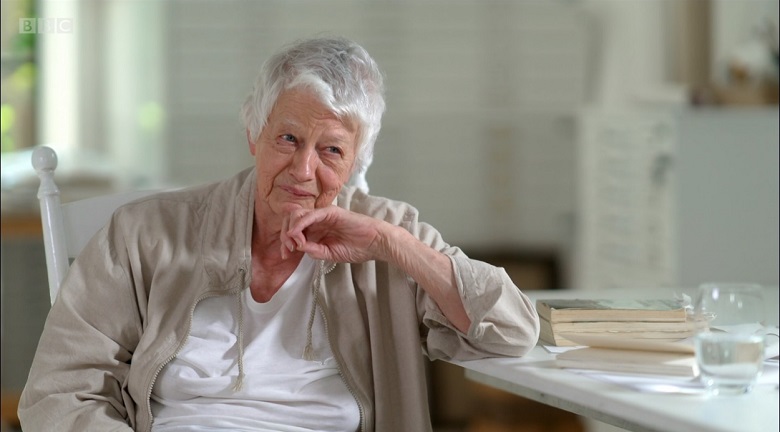|
|
| home | exhibitions | interviews | features | profiles | webprojects | archive |
|
Bridget Riley on colour, making a contribution and a childhood in Cornwall Interview Kirsty Wark Transcribed from Newsnight interview 2.6.21
...I had a big retrospective at the Hayward
gallery, just before Covid, and that gave me an opportunity to look at
my own work, from way back through my own past. And how it appeared to
me in the present, now, was very interesting. I found that the visitors
- the people who came to the show - were doing exactly the same thing.
So it wasn't only that my own eyesight had developed, but those who have
been following my work: their perception of my work had also changed. Do you see things that you didn't see before when you look back at your paintings maybe from 40 or 50 years ago? Do you look at them differently? Yes, but not always. Sometimes they're
entirely 'old friends', but at other times I see things in them which I
didn't intend, didn't see and that weren't apparent to me.
I think it was because we had evacuated
ourselves, my mother, my sister and I, and my father's sister. We were not far from the coast and you
could cross the road, and walk through a farmyard down a little lane,
until you arrived at a little pebble beach which, actually in fact, is
where I swam through a diamond. What is that? It is a description of actually swimming in a pool, which I can remember very well, having swam there very many times. And it was colour being faceted, so to speak. So that was the swimming through the diamond.
Do you think that your mother and your aunt actually saw something in you that was receptive to light and colour do you think? Well, my mother had what is called 'an eye'. She had a great eye.
But do you think it was then that you
made the foundations of an artistic personality? Do you think that's
from where it came? I think my father went to the war but was reported missing. We lost him for many, many years. And then we did hear that he was alive and then he came back. So the war was very personal, and at very close quarters indeed in some ways, but also happening miles and miles away.
As a war child when you were
conditioned to unpredictability and uncertainty. Was there a way that in
your art, you created a kind of rhythm and certainty in your art, and an
element of control. 'A movement in squares' (1961 - below): it
was one small change slowly, slowly, building on, building on, building
on, building on, until it accelerated into a rapid movement in the
square. It shuttled almost to extinction. And then it would have closed
the painting, there wouldn't have been anything there. I could do
nothing but come back. Then, then we see more, but it all takes time, and if they're willing to give time, which I was so absolutely thrilled to see they were then, through looking, you can learn to see.
When you move from black and white. That was momentous for you. Well, I was heading towards it, because I had reached a certain understanding of colour and certain ability to to deal with it in through my copy of Seurat, and had come to understand something very important about colour through that. The induction of colour, that is, colour can induce something it's not. So its immensely unstable, essentially, unstable. But because of that, a huge, exciting field to to work with.
Black and white is a colour isn't it really, They're wonderful colours and what's more they generate colours. They really do.
So do you think abstract is the right
word for you as an artist?
In your long career you've only done, use the 3D once. Tell me about why you only used it once; was it a success was it not success, Well that came about when The National
Gallery bought a big water lily painting, and you are enveloped in it.
You see the clouds in the sky, reflected down amongst the water lilies,
the whole world, and you're enveloped in it visually. And I thought I
would make a big painting, which envelops you physically, which was a
great mistake!
But if you hadn't done that, you wouldn't have known that that's where you wanted to be, and so is there ever such a thing as a mistake? No, you're quite right. In a way there's not, and as Matisse said 'don't get rid of your mistakes', meaning that they are the things that will help you to get to move, and to think, and to understand.
Looking now at where art, and artists
and art education is, is there a way do you think after this pandemic
that artists will find spaces to work in that they didn't have before;
all these big department stores and office blocks, is there a way that
artists should be inhabiting them for their good but also for our good.
Yes I do. I think that artists have, painters have, borne witness. It's one of the tasks, so to speak, to changing circumstances and events; to horrors, as well as to wonders. They've held a mirror up to human nature and reported faithfully.
I couldn't be couldn't say, that's for
other people to. And I suppose that I hope that when you asked me if I
could make a contribution that I'm hoping that I can in some way; to
order, stability, even pleasure, the joy of living. The great privilege
we have in being alive.
|
|
|


